浮头式换热器毕业设计说明书
- 格式:doc
- 大小:2.39 MB
- 文档页数:57
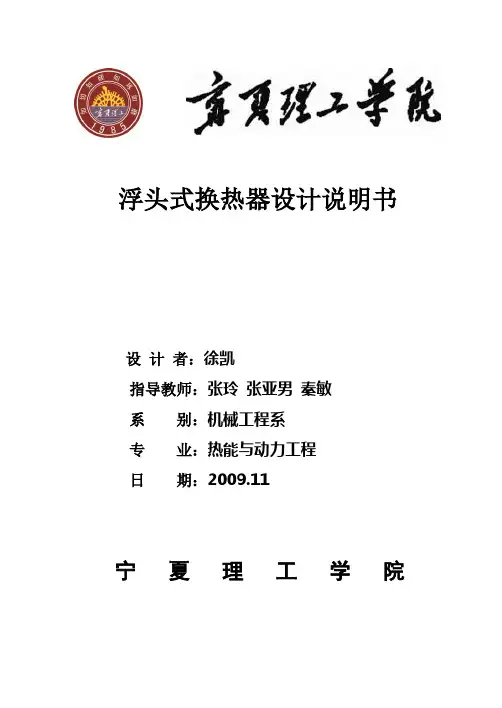
浮头式换热器设计说明书设计者:徐凯指导教师:张玲张亚男秦敏系别:机械工程系专业:热能与动力工程日期:2009.11宁夏理工学院前言换热器是非常重要的换热设备。
在国民生产的各个领域得到了广泛的应用。
本设计说明书主要介绍浮头式换热器的原理和设计思路及整个设计过程。
在浮头式换热器中,浮头式换热器的两端的管板,一端不与壳体相连,该端亦称浮头。
管子受热时,管束连同浮头可以沿轴向自由伸缩,完全消除了温差应力。
浮头式换热器主要有如下特点:浮头式换热器的一端管板固定在壳体与管箱之间,另一端管板可以在壳体内自由移动,这个特点在现场就能清楚地看出来。
这种换热器的壳体和管束的热膨胀是自由的,管束可以抽出,便于清洗管间和管内。
其缺点是结构复杂造价高,一般比固定管板高20%左右,在运行中浮头处发生泄漏不易检查处理。
浮头式换热器适应于壳体和管束温差较大或壳程介质易结垢的工作条件下。
本书内容系统、完整,理论与实际并重。
书中对浮头式换热器设计中所需的各学科知识均有简要的介绍和解释。
同时该书对换热器在编写时注重介绍的方法简明扼要,条理清楚,深入浅出,紧密结合工程实际。
期间得秦敏、张春兰、张亚男、张玲等老师的悉心指导。
在此表示真挚的感谢!由于编者水平有限,其中难免不妥之处,恳请各位读者批评指正。
编者:徐凯2009-11-26目录第一章绪论第二章设计任务和设计条件 (1)第三章确定设计方案 (3)3.1 换热器类型的确定 (3)3.2 管程及壳程的流体安排 (3)第四章确定物性数据 (4)4.1定性温度的确定 (4)4.2列表 (6)第五章传热面积的估算 (7)第六章工艺结构尺寸的确定 (9)6.1 管径和管内流速的确定 (9)6.2 管程数和传热管数的确定 (9)6.3 平均传热温差的校正 (10)6.4 传热管排列和分程方法确定 (10)6.5 壳体内径的确定 (11)6.6 折流板的确定 (11)6.7 其它附件的确定 (12)第七章所设计换热器的校核算 (13)7.1 传热热流量的核算 (13)7.2 壁温的校核计算 (15)7.3 换热器内流体的流动阻力的核算 (17)参考文献 (19)换热器原理课程设计心得体会 (21)第一章绪论1.1换热器课程设计的目的和要求课程设计是《换热器原理》课程的一个总结性教学环节,是培养学生综合运用本门课程及有关课程的基本知识去解决某一设计任务的一次训练。
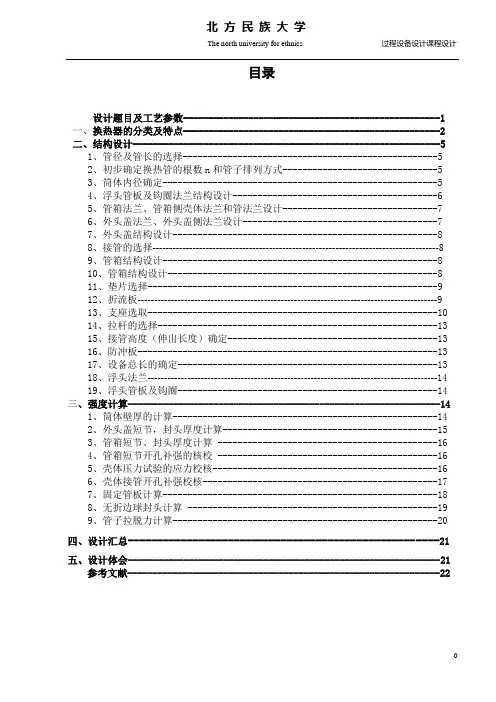
目录设计题目及工艺参数---------------------------------------------------1一、换热器的分类及特点---------------------------------------------------2二、结构设计-------------------------------------------------------------51、管径及管长的选择---------------------------------------------------52、初步确定换热管的根数n和管子排列方式-------------------------------53、筒体内径确定-------------------------------------------------------54、浮头管板及钩圈法兰结构设计-----------------------------------------65、管箱法兰、管箱侧壳体法兰和管法兰设计-------------------------------76、外头盖法兰、外头盖侧法兰设计---------------------------------------77、外头盖结构设计-----------------------------------------------------88、接管的选择--------------------------------------------------------------------------------------89、管箱结构设计-------------------------------------------------------810、管箱结构设计------------------------------------------------------811、垫片选择----------------------------------------------------------912、折流板------------------------------------------------------------------------------------------913、支座选取----------------------------------------------------------1014、拉杆的选择--------------------------------------------------------1315、接管高度(伸出长度)确定------------------------------------------1316、防冲板------------------------------------------------------------1317、设备总长的确定----------------------------------------------------1318、浮头法兰---------------------------------------------------------------------------------------1419、浮头管板及钩圈----------------------------------------------------14三、强度计算--------------------------------------------------------------141、筒体壁厚的计算-----------------------------------------------------142、外头盖短节,封头厚度计算-------------------------------------------153、管箱短节、封头厚度计算 --------------------------------------------164、管箱短节开孔补强的核校 --------------------------------------------165、壳体压力试验的应力校核---------------------------------------------166、壳体接管开孔补强校核-----------------------------------------------177、固定管板计算-------------------------------------------------------188、无折边球封头计算 --------------------------------------------------199、管子拉脱力计算-----------------------------------------------------20四、设计汇总-----------------------------------------------------21五、设计体会--------------------------------------------------------------21参考文献--------------------------------------------------------------22设计题目:浮头式换热器工艺参数:管口表:符号公称直径(mm)管口名称a 130 变换气进口b 130 软水出口c 130 变换气出口d 130 软水进口e 50 排尽口设备选择原理及原因:浮头式换热器的结构较复杂,金属材料耗量较大,浮头端出现内泄露不易检查出来,由于管束与壳体间隙较大,影响传热效果。
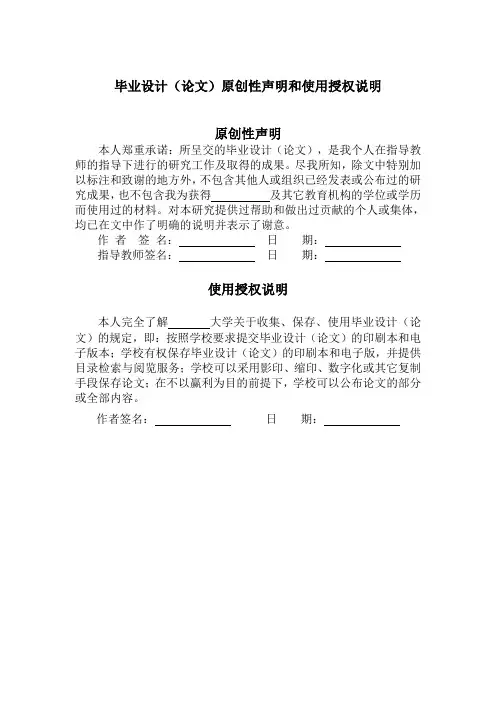

浮头式换热器毕业设计毕业设计(论文)专业:过程装备与控制工程题目:BJS1200浮头式冷凝器设计作者姓名:导师及职称:导师所在单位:二〇一三年六月十六日本科毕业设计(论文)任务书2012 届机械与汽车工程学院过程装备与控制工程专业学生姓名:Ⅰ毕业设计(论文)题目中文:BJS1200浮头式冷凝器设计英文:The design ofBJS1200 floating head condenserⅡ原始资料1. 马小明、钱颂文、朱冬生等. 管壳式换热器[M],北京:中国石化出版社,2010.2. 董其伍、张垚。
换热器 [M],北京:化学工业出版社,2008.3.GB_151-1999_管壳式换热器Ⅲ毕业设计(论文)任务内容1、课题研究的意义换热器是国民经济和工业生产领域中应用十分广泛的热量交换设备。
随着现代新工艺、新技术、新材料的不断开发和能源问题的日趋严重,世界各国已普遍把石油化工深度加工和能源综合利用摆到十分重要的位置。
换热器因而面临着新的挑战。
换热器的性能对产品质量、能量利用率以及系统运行的经济性和可靠性起着重要的作用,有时甚至是决定性的作用。
目前在发达的工业国家热回收率已达 96%。
换热设备在现代装置中约占设备总重的 30%左右,其中管壳式换热器仍然占绝对的优势,约 70%。
其余 30%为各类高效紧凑式换热器、新型热管热泵和蓄热器等设备,其中板式、螺旋板式、板翅式以及各类高效传热元件的发展十分迅速。
在继续提高设备热效率的同时,促进换热设备的结构紧凑性,产品系列化、标准化和专业化,并朝大型化的方向发展。
浮头式换热器是管壳式换热器系列中的一种,换热管束包括换热管、管板、折流板、支持板、拉杆、定距管等。
换热管可为普通光管,也可为带翅片的翅片管,翅片管有单金属整体轧制翅片管、双金属轧制翅片管、绕片式翅片管、叠片式翅片管等,材料有碳钢、低合金钢、不锈钢、铜材、铝材、钛材等。
壳体一般为圆筒形,也可为方形。
管箱有椭圆封头管箱、球形封头管箱和平盖管箱等。

目录设计题目及工艺参数---------------------------------------------------1一、换热器的分类及特点---------------------------------------------------2二、结构设计-------------------------------------------------------------51、管径及管长的选择---------------------------------------------------52、初步确定换热管的根数n和管子排列方式-------------------------------53、筒体内径确定-------------------------------------------------------54、浮头管板及钩圈法兰结构设计-----------------------------------------65、管箱法兰、管箱侧壳体法兰和管法兰设计-------------------------------76、外头盖法兰、外头盖侧法兰设计---------------------------------------77、外头盖结构设计-----------------------------------------------------88、接管的选择--------------------------------------------------------------------------------------89、管箱结构设计-------------------------------------------------------810、管箱结构设计------------------------------------------------------811、垫片选择----------------------------------------------------------912、折流板------------------------------------------------------------------------------------------913、支座选取----------------------------------------------------------1014、拉杆的选择--------------------------------------------------------1315、接管高度(伸出长度)确定------------------------------------------1316、防冲板------------------------------------------------------------1317、设备总长的确定----------------------------------------------------1318、浮头法兰---------------------------------------------------------------------------------------1419、浮头管板及钩圈----------------------------------------------------14三、强度计算--------------------------------------------------------------141、筒体壁厚的计算-----------------------------------------------------142、外头盖短节,封头厚度计算-------------------------------------------153、管箱短节、封头厚度计算 --------------------------------------------164、管箱短节开孔补强的核校 --------------------------------------------165、壳体压力试验的应力校核---------------------------------------------166、壳体接管开孔补强校核-----------------------------------------------177、固定管板计算-------------------------------------------------------188、无折边球封头计算 --------------------------------------------------199、管子拉脱力计算-----------------------------------------------------20四、设计汇总-----------------------------------------------------21五、设计体会--------------------------------------------------------------21参考文献--------------------------------------------------------------22设计题目:浮头式换热器工艺参数:管口表:符号公称直径(mm)管口名称a 130 变换气进口b 130 软水出口c 130 变换气出口d 130 软水进口e 50 排尽口设备选择原理及原因:浮头式换热器的结构较复杂,金属材料耗量较大,浮头端出现内泄露不易检查出来,由于管束与壳体间隙较大,影响传热效果。
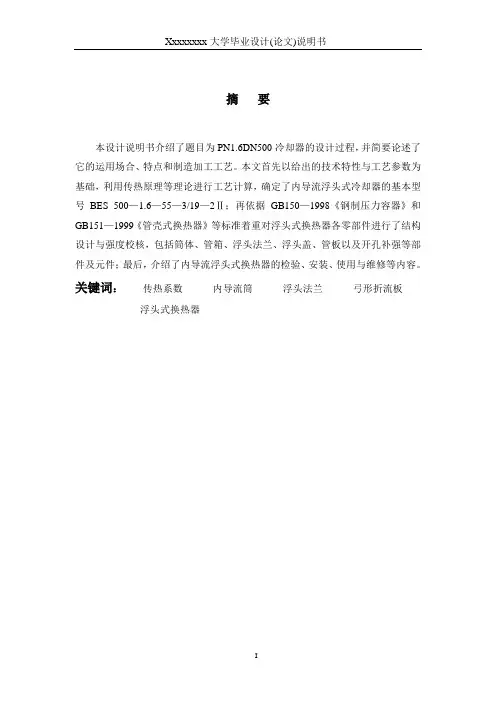
摘要本设计说明书介绍了题目为PN1.6DN500冷却器的设计过程,并简要论述了它的运用场合、特点和制造加工工艺。
本文首先以给出的技术特性与工艺参数为基础,利用传热原理等理论进行工艺计算,确定了内导流浮头式冷却器的基本型号BES 500—1.6—55—3/19—2Ⅱ;再依据GB150—1998《钢制压力容器》和GB151—1999《管壳式换热器》等标准着重对浮头式换热器各零部件进行了结构设计与强度校核,包括筒体、管箱、浮头法兰、浮头盖、管板以及开孔补强等部件及元件;最后,介绍了内导流浮头式换热器的检验、安装、使用与维修等内容。
关键词:传热系数内导流筒浮头法兰弓形折流板浮头式换热器AbstractThis design specifications introduces the design process of PN1.6 DN500 cooler, and expounds briefly the utilization situation、characteristic and manufacture process. Firstly, It is based on physical technical characteristic and technology parameter given in the production that the technology calculation is done by making use of fundamentals about heat transfer process in order to define the model of floating-head type cooler with inner diversion tube,which is BES 500—1.6—44.9—3/25—2Ⅱ. Then, the structural design and intensity examination about most of components in heat exchanger are carried out by means of standards, such as GB150—1998<Steel pressure vessels> and GB151—1999<shell and tube heat exchanger>,including tube body、tube box、floating head flange、floating head cover、the tube plate as well as reinforcement for opening and so on. Finally, it is also related to inspection、installation、operation and maintenance about floating-head type heat exchanger with inner diversion tube.Key word: heat transfer coefficient ;inner diversion tube ; floating head flange;flow resistance;segmental baffle;floating-head type heat exchanger ;目录摘要 (I)Abstract....................................................... I I 绪论. (1)第一章方案论证 (5)1.2 经济合理性 (7)1.3 结构可操作性 (7)第二章结构及强度设计 (9)2.1 筒体结构设计及计算[1] (9)2.1.1. 筒体厚度计算 (9)2.1.2 筒体的强度校核和水压试验 (10)2.2 管箱结构设计 (11)2.2.1封头的材料及形式选择[14] (11)2.2.2标准封头壁厚计算 (11)2.2.3管箱应力校核 (12)2.2.4 管箱的结构设计 (12)2.3 管箱法兰设计 (13)2.3.1 法兰选用[5] (13)2.3.2垫片选用[8] (13)2.3.3螺柱与螺母选用[5] (14)2.3.4管箱法兰计算及校核[2] (14)2.4 钩圈式浮头的设计 (19)2.4.1 钩圈式浮头的结构尺寸计算 (19)2.4.2 浮头盖的设计计算 (20)2.4.3浮头钩圈的设计计算 (28)2.5 换热管及管板的设计 (28)2.5.1、换热管的设计 (28)2.5.2 换热器管板设计 (30)2.6 外头盖设计 (35)2.6.1 外头盖侧法兰选用[10] (35)2.6.2.外头盖法兰选用[5] (36)2.6.3.外头盖垫片及其它[9] (36)2.6.4 外头盖封头的设计[14] (36)2.7 开孔补强设计[1] (37)3.7.1 补强判别 (37)2.7.3.封头开孔补强计算 (39)2.8 其他零部件设计[2] (40)2.8.1拉杆设计 (40)2.8.2 分程隔板设计 (41)2.8.3 定距管设计 (41)2.8.4滑道设计 (41)2.8.5 折流板的设计计算 (41)P) (43)2.8.6. 防冲板设计(GB151- 1999,762.8.7. 内导流筒的选用 (43)2.8.8. 防短路结构设计 (43)2.8.9. 鞍式支座的选用[11] (44)2.8.10. 预防管束发生振动破坏的措施 (45)第三章浮头式换热器的制造、检验与验收 (46)3.1浮头式换热器制造、检验与验收要求 (46)3.2浮头式换热器的制造工艺[4] (46)3.2.1主要零部件的加工工艺 (46)3.2.3 浮头式换热器的焊接工艺 (49)3.2.4 浮头式换热器的涂漆工艺 (51)3.3浮头式换热器的检验与验收 (51)3.3.1 换热器常见的试验工艺及要求 (52)3.3.2 浮头式换热器的检验工艺 (52)第四章浮头式换热器的安装、使用与维修 (54)4.1浮头式换热器的安装要求 (54)4.2浮头式换热器的使用与维修[4] (54)4.2.1浮头式换热器使用时常见的几种破坏形式 (54)4.2.2浮头式换热器的维修 (55)第五章分析与总结 (56)设计小结 (57)参考文献 (58)致谢 (59)绪论过程设备在生产技术领域中应用非常广泛,是化工、炼油、轻工、交通、食品、制药、冶金、能源、纺织、宇航、城建、国防、海洋工程等传统部门所必需的关键设备。
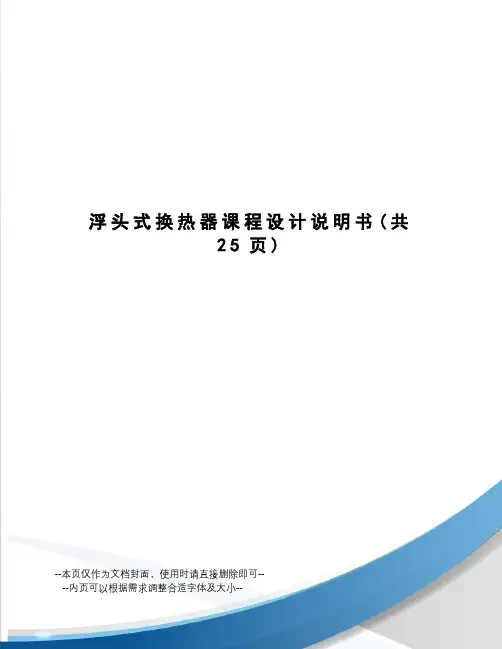
浮头式换热器课程设计说明书(共25页)--本页仅作为文档封面,使用时请直接删除即可----内页可以根据需求调整合适字体及大小--1.方案确定选择换热器的类型浮头式换热器:主要特点是可以从壳体中抽出便于清洗管间和管内。
管束可以在管内自由伸缩不会产生热应力。
换热面积的确定根据《化工设备设计手册》选择传热面积为 400m 2换热管数N 的确定我国管壳式换热器常用碳素钢、低合金钢钢管,其规格为φ19× 2、φ25× 、φ32× 3、φ38 × 3、φ57 × 等,不锈钢钢管规格为φ19 × 2、φ25 × 2、φ32 × 2、φ38 × 、φ57 × 。
换热管长度规格为、、、、、、、、等。
换热器换热管长度与公称直径之比,一般在 4~25 之间,常用的为 6~10。
管子的材料选择应根 据介质的压力、温度及腐蚀性来确定。
选用32×3mm 的无缝钢管,材质为 0Cr18Ni9,管长为 6000mmn=A/πd 0L 3-5式 3-5:n —换热管数 A —换热面积m 2 d0—换热管外径mm L —换热管长度mm故 -3-3400n==6133.1432600010⨯⨯10⨯⨯根表拉杆直径 /mm表拉杆数量换热器公称直径DN/mm400<d400≤d<700700≤d<900900≤d<2600 44810拉杆需 10根。
换热管的排布与连接方式的确定换热管排列形式如图所示。
换热管在管板上的排列形式主要有正三角形、正方形和转正三角形、转三角形。
正三角形排列形式可以在同样的管板面积上排列最多的管数,故用的最为广泛,但管外不易清洗。
为便于管外便于清洗可以采用正方形或转正方形的管束。
换热管中心距要保证管子与管板连接时,管桥有足够的强度和宽度。
管间需要清洗时还要留有进行清洗的通道。
换热管中心距宜不小于倍的换热管的外径。
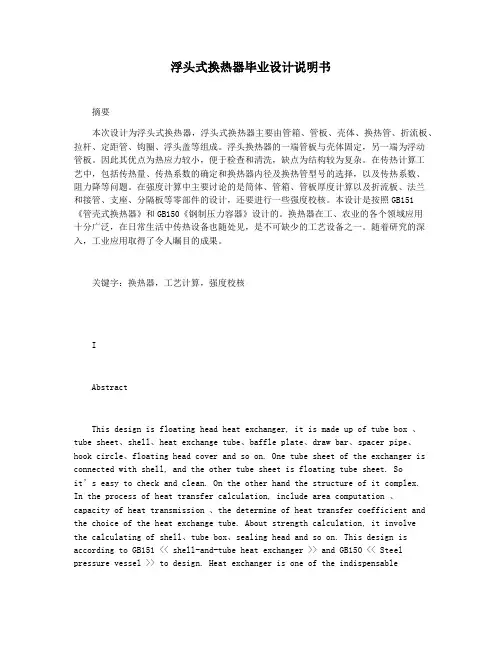
浮头式换热器毕业设计说明书摘要本次设计为浮头式换热器,浮头式换热器主要由管箱、管板、壳体、换热管、折流板、拉杆、定距管、钩圈、浮头盖等组成。
浮头换热器的一端管板与壳体固定,另一端为浮动管板。
因此其优点为热应力较小,便于检查和清洗,缺点为结构较为复杂。
在传热计算工艺中,包括传热量、传热系数的确定和换热器内径及换热管型号的选择,以及传热系数、阻力降等问题。
在强度计算中主要讨论的是筒体、管箱、管板厚度计算以及折流板、法兰和接管、支座、分隔板等零部件的设计,还要进行一些强度校核。
本设计是按照GB151《管壳式换热器》和GB150《钢制压力容器》设计的。
换热器在工、农业的各个领域应用十分广泛,在日常生活中传热设备也随处见,是不可缺少的工艺设备之一。
随着研究的深入,工业应用取得了令人瞩目的成果。
关键字:换热器,工艺计算,强度校核IAbstractThis design is floating head heat exchanger, it is made up of tube box 、tube sheet、shell、heat exchange tube、baffle plate、draw bar、spacer pipe、hook circle、floating head cover and so on. One tube sheet of the exchanger is connected with shell, and the other tube sheet is floating tube sheet. Soit’s easy to check and clean. On the other hand the structure of it complex.In the process of heat transfer calculation, include area computation 、capacity of heat transmission 、the determine of heat transfer coefficient and the choice of the heat exchange tube. About strength calculation, it involvethe calculating of shell、tube box、sealing head and so on. This design is according to GB151 << shell-and-tube heat exchanger >> and GB150 << Steel pressure vessel >> to design. Heat exchanger is one of the indispensableprocess equipment. With the deepening of the research, industrial application made remarkable achievements.Keywords: heat exchanger; Process calculation ;strength checkII目录摘要............................................................................ .............................................................................. .. (I)Abstract ..................................................................... .............................................................................. ........ II 前言............................................................................ .............................................................................. ....... 1 第一章概述 ........................................................................... (2)1.1 何为换热器 ........................................................................... ......................................................... 2 1.2 换热器的应用 ........................................................................... ..................................................... 2 1.3 换热器分类 ........................................................................... (3)1.3.1 按传热原理分类 ........................................................................... ...................................... 3 1.3.2 按结构分类 ........................................................................... .............................................. 3 1.3.3 按传热种类分类 ........................................................................... ...................................... 3 1.3.4 按强化传热元件分类 ........................................................................... .............................. 3 1.3.5 按材料分类 ........................................................................... .............................................. 3 1.4 换热器的结构和使用特点 ........................................................................... (4)1.4 .1 浮头式换热器 ........................................................................... ......................................... 4 1.4.2 固定管板式换热器 ........................................................................... .................................. 5 1.4.3 U形管换热器 ........................................................................... .......................................... 6 1.5 设计的思想 ........................................................................... (7)1.5.1 首先设计必须满足生产需要 ........................................................................... .................. 7 1.5.2 设计必须安全可靠 ........................................................................... .................................. 7 1.5.3 设计必须经济合理 ........................................................................... .................................. 7 1.6 设计的特点 ........................................................................... ......................................................... 8 第二章设计主要参数 ........................................................................... .. (9)2.1 原始数据 ........................................................................... ............................................................. 9 2.2 定性温度及物性参......................................... 9 第三章零件结构型式的选择 ........................................................................... (10)3.1 前端管箱 ........................................................................... ........................................................... 10 3.2 壳体 ........................................................................... .................................................................... 11 3.3 后端管箱 ........................................................................... ............................................................ 11 3.4 管束分程和分程隔板的布置 ........................................................................... . (11)3.4.1 管束分程 ........................................................................... ................................................. 11 3.4.2 分程隔板的布置 ........................................................................... ..................................... 11 3.5 换热管 ........................................................................... (12)3.5.1 换热管的长度 ........................................................................... ........................................ 12 3.5.2 规格及尺寸偏差 ........................................................................... .................................... 12 3.5.3 布管 ........................................................................... ........................................................ 12 3.6 管子与管板的连接 ........................................................................... ........................................... 13 3.7 管板与壳体的连接 ........................................................................... ........................................... 14 3.8 折流板、支持板的选择 ........................................................................... ................................... 15 3.9 拉杆的选 (15)III3.10 定距管的选择 ........................................................................... ................................................. 16 3.11 防冲板的选择 ........................................................................... ................................................. 16 3.12 排液口和排气口的选择 ........................................................................... ................................. 16 第四章传热工艺技术 ........................................................................... (18)4.1 有效平均温度 ........................................................................... ................................................... 18 4.2 传热量和流量 ........................................................................... ................................................... 18 4.3 管程换热系数计算 ........................................................................... ........................................... 19 4.4 结构初步设计 ........................................................................... ................................................... 19 4.5 壳程换热系数计算 ........................................................................... ........................................... 20 4.6 强度计算 ........................................................................... .. (21)4.6.1 换热管材料及规格的选择和根数的确定 (21)4.6.2 确定壳体内径 ........................................................................... ........................................ 21 4.6.3 确定壳体壁厚 ........................................................................... ........................................ 21 4.6.4 壳体液压试验 ........................................................................... ........................................ 22 4.6.5 管箱封头厚度计................................ 23 4.6.6 管箱短节厚壁计算 ........................................................................... ................................ 24 4.6.7 管箱液压试验 ........................................................................... ........................................ 24 4.6.8 管板的设计 ........................................................................... ............................................ 25 4.6.9 钩圈式浮头 ........................................................................... ............................................ 25 4.6.10 管程压力作用下浮头盖的设计 ........................................................................... ............ 26 4.6.11 浮头侧封头厚度 ........................................................................... .................................... 26 4.6.12 折流板的选择 ........................................................................... ........................................ 27 4.6.13 设备法兰的选择 ........................................................................... .................................... 28 4.7 换热面积校核 ........................................................................... ................................................... 35 4.8 支座强度校核 ........................................................................... (36)4.8.1 反力计算 ........................................................................... ................................................ 37 4.8.2 筒体轴向弯矩计算 ........................................................................... ................................ 37 4.8.3 筒体轴向弯曲应力校核 ........................................................................... ........................ 38 4.8.4 鞍座腹板强度校核 ........................................................................... ................................ 38 4.9 阻力计算 ........................................................................... .. (38)4.9.1 管程阻力计算 ........................................................................... ........................................ 38 4.9.2 壳程压力 (39)第五章整体尺寸布局 ........................................................................... ...................................................... 42 结论............................................................................ .............................................................................. ..... 43 致谢............................................................................ .............................................................................. ..... 44 参考文献 ........................................................................... ............................................................................45IV前言前言毕业设计是完成教学计划实现专业培养目标的一个重要的教学环节;是教学计划中综合性最强的实践性教学环节。
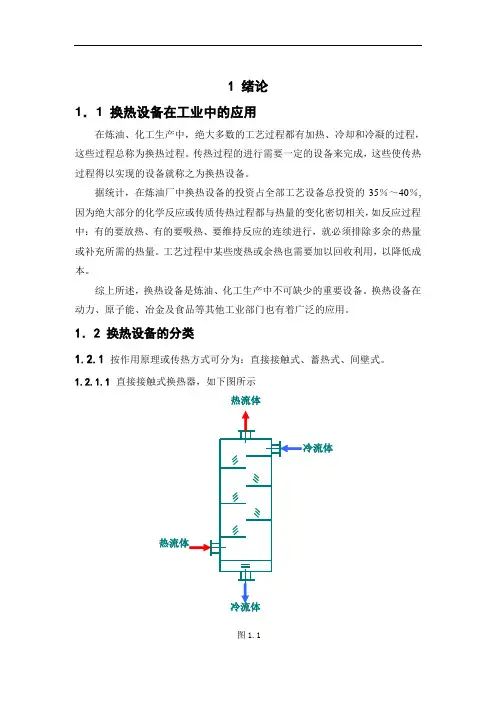
1 绪论1.1 换热设备在工业中的应用在炼油、化工生产中,绝大多数的工艺过程都有加热、冷却和冷凝的过程,这些过程总称为换热过程。
传热过程的进行需要一定的设备来完成,这些使传热过程得以实现的设备就称之为换热设备。
据统计,在炼油厂中换热设备的投资占全部工艺设备总投资的35%~40%,因为绝大部分的化学反应或传质传热过程都与热量的变化密切相关,如反应过程中:有的要放热、有的要吸热、要维持反应的连续进行,就必须排除多余的热量或补充所需的热量。
工艺过程中某些废热或余热也需要加以回收利用,以降低成本。
综上所述,换热设备是炼油、化工生产中不可缺少的重要设备。
换热设备在动力、原子能、冶金及食品等其他工业部门也有着广泛的应用。
1.2 换热设备的分类1.2.1按作用原理或传热方式可分为:直接接触式、蓄热式、间壁式。
1.2.1.1直接接触式换热器,如下图所示热流体图1.1其传热的效果好,但不能用于发生反应或有影响的流体之间。
蓄热式换热器,如下图所示图1.2其适用于温度较高的场合,但有交叉污染,温度被动大。
1.2.1.3 间壁式换热器,又称表面式换热器利用间壁进行热交换。
冷热两种流体隔开,互不接触,热量由热流体通过间壁传递给冷流体。
1.2.2 按其工艺用途可分为:冷却器(cooler)、冷凝器(condenser)、加热器(一般不发生相变)(heater)、蒸发器(发生相变)(evaporator)、再沸器(reboiler)、废热锅炉(waste heat boiler)。
1.2.3 按材料分类:分为金属材料和非金属材料换热器。
1.3 国内外的研究现状上个世纪70年代初发生世界性能源危机,有力地促进了传热强化技术的发展。
为了节能降耗,提高工业生产的经济效益,要求开发适用不同工业过程要求的高效能换热设备。
因此,几十年来,高效换热器的开发与研究始终是人们关注的课题,国内外先后推出了一系列新型高效换热器。
近年来,国内已经进行了大量的强化传热技术的研究,但在新型高效换热器的开发方面与国外差距仍然较大,并且新型高效换热器的实际推广和应用仍非常有限。
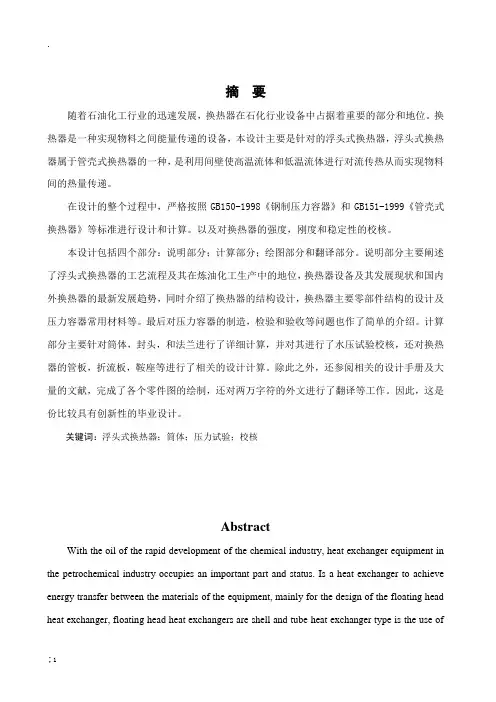
摘要随着石油化工行业的迅速发展,换热器在石化行业设备中占据着重要的部分和地位。
换热器是一种实现物料之间能量传递的设备,本设计主要是针对的浮头式换热器,浮头式换热器属于管壳式换热器的一种,是利用间壁使高温流体和低温流体进行对流传热从而实现物料间的热量传递。
在设计的整个过程中,严格按照GB150-1998《钢制压力容器》和GB151-1999《管壳式换热器》等标准进行设计和计算。
以及对换热器的强度,刚度和稳定性的校核。
本设计包括四个部分:说明部分;计算部分;绘图部分和翻译部分。
说明部分主要阐述了浮头式换热器的工艺流程及其在炼油化工生产中的地位,换热器设备及其发展现状和国内外换热器的最新发展趋势,同时介绍了换热器的结构设计,换热器主要零部件结构的设计及压力容器常用材料等。
最后对压力容器的制造,检验和验收等问题也作了简单的介绍。
计算部分主要针对筒体,封头,和法兰进行了详细计算,并对其进行了水压试验校核,还对换热器的管板,折流板,鞍座等进行了相关的设计计算。
除此之外,还参阅相关的设计手册及大量的文献,完成了各个零件图的绘制,还对两万字符的外文进行了翻译等工作。
因此,这是份比较具有创新性的毕业设计。
关键词:浮头式换热器;筒体;压力试验;校核AbstractWith the oil of the rapid development of the chemical industry, heat exchanger equipment in the petrochemical industry occupies an important part and status. Is a heat exchanger to achieve energy transfer between the materials of the equipment, mainly for the design of the floating head heat exchanger, floating head heat exchangers are shell and tube heat exchanger type is the use ofpartitions so that high-temperature fluid and low-temperature fluid for convective heat transfer in order to achieve the heat transfer between materials.In the design of the whole process, in strict accordance with GB150-1998 "Steel Pressure Vessels" and GB151-1999 "shell and tube heat exchanger" and other standards for the design and calculation. As well as the heat exchanger strength, stiffness and stability of the check.The design includes four parts: that part of it; calculation part; mapping and translation of some parts. Note on some of the main floating head heat exchanger and its application in the process of refining the position of chemical production, heat exchanger and the development of equipment and heat exchangers at home and abroad the latest development trends, at the same time introduced the structure of heat exchanger design, heat exchanger design of the structure of the main components and pressure vessels commonly used materials. Finally, pressure vessel manufacturing, testing and acceptance of other issues also made a brief introduction. Calculated for some of the main cylinder, head, and carried out a detailed calculation of the flange, and its hydraulic test checking, but also on the heat exchanger tube sheet, baffle, such as a saddle-related design calculation. In addition, see the related design manuals and a lot of literature, completed the mapping of various parts, but also on the20,000 foreign-language characters for the translation work. Therefore, it is a comparison of graduates with innovative design.Key words:Floating head heat exchanger; cylinder; pressure test; check目录1前言 (1)1.1管壳式换热器的分类 (1)1.2管壳式换热器的结构 (2)1.2.1管束 (2)1.2.2壳程 (3)1.2.3管子的排列方式 (3)1.2.4管板 (3)1.2.5折流板与折流杆 (3)1.3管壳式换热器相关分析 (4)1.3.1传热系数 (4)1.3.2平均温差 (4)1.3.3流体流速 (4)1.3.4流体压降 (4)1.3.5振动 (4)1.3.6其他 (4)1.4提高管壳式换热器传热能力的措施 (5)1.5管壳式换热器工作原理 (6)1.6管壳式换热器的发展 (7)1.6.1板式支承结构的发展 (7)1.6.2杆式支承结构的发展 (7)1.6.3空心环支承结构 (8)1.6.4管式自支承 (9)1.7管壳式换热器特点 (10)1.8管壳式与其他换热器的比较 (11)1.9腐蚀与防护 (14)1.9.1换热器腐蚀的原因 (14)1.9.2管壳式换热器的防腐蚀措施 (16)1.10换热器设计软件简介 (19)1.10.1HTFS (20)1.10.2 HTRI (21)1.10.3 ASPEN PLUS B—JAC (22)1.11结语 (23)2设计部分 (24)2.1浮头式换热器筒体的计算: (24)2.1.1计算条件 (24)2.1.2厚度的计算 (24)2.2前后端管箱封头的计算 (25)2.2.1设计条件 (25)2.2.2厚度计算 (25)2.2.3压力试验应力校核 (26)2.2.4压力试验应力校核 (27)2.3带法兰无折边球形封头及法兰计算 (27)2.3.1设计条件 (27)2.3.2厚度计算 (28)2.4管子排列方式的设计 (31)2.5开孔补强的计算 (31)2.5.1筒体开孔所需的补强面积要求 (32)2.5.2在有效补强范围内作为补强的截面积 (32)2.5.3选择补强圈补强 (33)2.6外头盖法兰厚度计算 (33)2.6.1设计条件 (33)2.6.2厚度计算 (34)2.7管板的厚度计算 (38)2.7.1设计条件 (38)2.7.2计算各参数 (39)2.7.3厚度计算 (41)2.7.4校核换热管轴向力 (42)3 致谢 (45)4 参考文献 (46)1 前言换热器是一种实现物料之间热量传递的节能设备,在石油、化工、冶金、电力、轻工、食品等行业应用普遍。
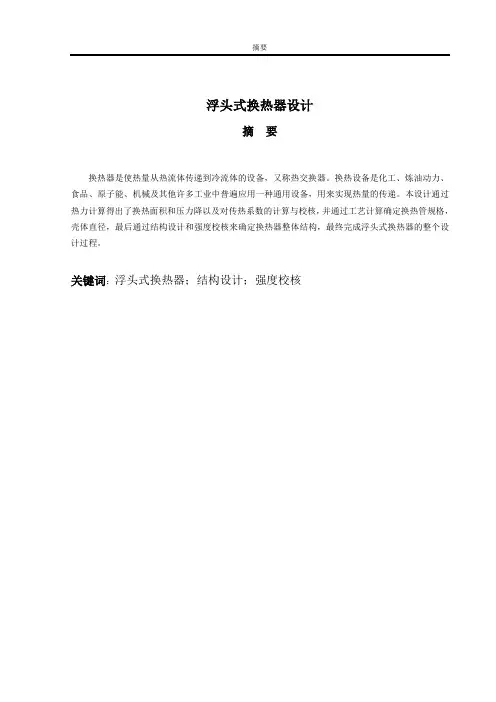
浮头式换热器设计说明书摘要本设计说明书是关于浮头式换热器的设计,主要是进行了换热器的工艺计算、换热器的结构和强度设计。
设计的前半部分是工艺计算部分,主要是根据给定的设计条件估算换热面积,从而进行换热器的选型,校核传热系数,计算出实际的换热面积,最后进行压力降和壁温的计算。
设计的后半部分则是关于结构和强度的设计,主要是根据已经选定的换热器型式进行设备内各零部件(如接管、折流板、定距管、钩圈、管箱等)的设计,包括:材料的选择、具体尺寸确定、确定具体位置、管板厚度的计算、浮头盖和浮头法兰厚度的计算、开孔补强计算等。
关于浮头式换热器设计的各个环节,设计说明书中都有详细的说明。
浮头式换热器:其结构如图2所示。
管子一端固定在一块固定管板上,管板夹持在壳体法兰与管箱法兰之间,用螺栓连接;管子另一端固定在浮头管板上,浮头管板夹持在用螺柱连接的浮头盖与钩圈之间,形成可在壳体内自由移动的浮头,故当管束与壳体受热伸长时,两者互不牵制,因而不会产生温差应力。
浮头部分是由浮头管板,钩圈与浮头端盖组成的可拆联接,因此可以容易抽出管束,故管内管外都能进行清洗,也便于检修。
由上述特点可知,浮头式换热器多用于温度波动和温差大的场合,尽管与固定管板式换热器相比其结构更复杂、造价更高。
1.1设计任务根据给定的工艺设计条件,此设计为无相变热、冷流体间换热的浮头式换热器设计任务。
1.2总体设计①确定结构形式。
由于介质换热温差较大,因此选用浮头式换热器。
②合理安排流程。
安排冷的污水走壳程,处理过的热清水走管程。
1.3热工计算①原始数据○2定性温度与物性参数○3物料与热量恒算○4有效平均温差○5初算传热面积○6换热器结构设计○7管程传热与压降○8壳程传热与压降结构设计与强度设计1)换热流程设计:采用壳程为单程、管程为单程的结构型式.2)换热管及其排列方式:采用的无缝钢管,材料为2520钢,热管排列方式为三角形排列,如图所示,共101根。
另外6根拉杆,共排列107根。
1 绪论1.1 换热设备在工业中的应用在炼油、化工生产中,绝大多数的工艺过程都有加热、冷却和冷凝的过程,这些过程总称为换热过程。
传热过程的进行需要一定的设备来完成,这些使传热过程得以实现的设备就称之为换热设备。
据统计,在炼油厂中换热设备的投资占全部工艺设备总投资的35%~40%,因为绝大部分的化学反应或传质传热过程都与热量的变化密切相关,如反应过程中:有的要放热、有的要吸热、要维持反应的连续进行,就必须排除多余的热量或补充所需的热量。
工艺过程中某些废热或余热也需要加以回收利用,以降低成本。
综上所述,换热设备是炼油、化工生产中不可缺少的重要设备。
换热设备在动力、原子能、冶金及食品等其他工业部门也有着广泛的应用。
1.2 换热设备的分类1.2.1按作用原理或传热方式可分为:直接接触式、蓄热式、间壁式。
1.2.1.1直接接触式换热器,如下图所示热流体图1.1其传热的效果好,但不能用于发生反应或有影响的流体之间。
蓄热式换热器,如下图所示图1.2其适用于温度较高的场合,但有交叉污染,温度被动大。
1.2.1.3 间壁式换热器,又称表面式换热器利用间壁进行热交换。
冷热两种流体隔开,互不接触,热量由热流体通过间壁传递给冷流体。
1.2.2 按其工艺用途可分为:冷却器(cooler)、冷凝器(condenser)、加热器(一般不发生相变)(heater)、蒸发器(发生相变)(evaporator)、再沸器(reboiler)、废热锅炉(waste heat boiler)。
1.2.3 按材料分类:分为金属材料和非金属材料换热器。
1.3 国内外的研究现状上个世纪70年代初发生世界性能源危机,有力地促进了传热强化技术的发展。
为了节能降耗,提高工业生产的经济效益,要求开发适用不同工业过程要求的高效能换热设备。
因此,几十年来,高效换热器的开发与研究始终是人们关注的课题,国内外先后推出了一系列新型高效换热器。
近年来,国内已经进行了大量的强化传热技术的研究,但在新型高效换热器的开发方面与国外差距仍然较大,并且新型高效换热器的实际推广和应用仍非常有限。
4746/168400 T JB MnR EHA -⨯装订线4. 管板与换热管的连接:管板与换热管采用胀接的形式,胀接长度mml37=,对于规格为5.225⨯φ换热管,由于管板壁厚2540>,为5.0322==+Kmml,,连接方式如下:5. 换热管中心距:由换热管外径mmd25=外,中心距mmt32=,根据GB151-1999标准,可查得分隔板槽两侧相邻管中心距mmSn44=6. 布管限定圆:根据GB151-1999标准,对于浮头式换热器,其布管限定圆直径为:)21(2bbbDDnL++-=b1=3b2=4b=11.52575.0min⋅≥δmm75.18=21075.18++≥δmm75.30=取标准设计值:mm40=δ装订线7. 管板管孔:根据GB151-1999标准,Ⅰ级管束(碳素钢管),当换热器mmd25=外时,其管孔直径mmd25.25=孔,允许偏差为:0~15.0+8. 管板连接:根据GB151-1999标准,管板与壳程圆筒、管板与法兰之间选择a型连接方式a型连接方式为:管板通过垫片于壳体法兰何管箱法兰连接管板与管箱用螺柱、垫片平面密封连接9. 壳体接管:由前已知壳体接管mmd1001=,管箱接管mmd802=,363=LD装订线16球冠形封头钩圈式浮头换热器外头盖推荐使用球冠形封头,根据《JB04746T.02钢制压力容器用封头》标准,取封头为DN500⨯8的PSH球冠形封头,总深度H=65mm,内表面积22033.0mA=,容积30063.0mV=,封头质量kgM9739.12=R=50017. 容器法兰1:根据JB-T4701-2000标准选取长颈对焊法兰,形式为突面密封面类型,则取MPaPN0.1=,mmDN400=,规格为:4559550054031====DHDD 23344524===dD δ,配合螺柱为:20M20个结构如图所示:mmA1383≤即可装订线2:根据JB-T4701-2000标准选取长颈对焊法兰,形式为凹凸面密封面类型,则取MPaPN0.1=,mmDN500=,规格为:55510060064031====DHDD 23385524===dD δ,配合螺柱为:20M20个结构如图所示:3:根据JB-T4721-92外头盖侧法兰,形式为凸面密封面类型,则取MPaPN0.1=,mmDN400=,规格为:5559060064031====DHDD 23325524===dD δ,配合螺柱为:20M20个结构如图所示:4钩圈式浮头法兰480800=+=i f D D372)104(2400)1(2=+-=++=bn b D D i fi426186290=+=b D3946400=-=c Dmm D G 384)53200(2=--=18钩圈 选择A 型钩圈t t ][σ=113直径比K=1.29查GB150-1998第九章,得Y=7.77120)](5.0[5.0=+-=fi c b D D D La厚度δ=42mm19管板计算:对延长部分兼做法兰的固定管板根据GB151-1999,初始数据:垫片压紧力作用中心圆直径384mm管子: 管子外径:mm d 25=外 管子壁厚:mm5.2=δ管子根数:mm n68=浙江工业大学课题:浮头式换热器设计班级:过控0601学号:200602060120设计者:徐庆清。
浮头式换热器的设计摘要本设计说明书是关于浮头式换热器的设计,主要是进行了换热器的工艺计算、换热器的结构和强度设计。
换热器是化工、炼油、动力、食品、轻工、原子能、制药、机械及其它许多工业部门广泛使用的一种通用设备。
近二三十年来,化工、石油、轻工等过程工业得到了迅猛发展。
因此,要求提供尺寸小,重量轻、换热能力大的换热设备。
在设计过程中,我尽量采用较新的国家标准,做到既满足设计要求,又使结构优化,降低成本,以提高经济效益为主,力争使产品符合生产实际需要,适合市场激烈的竞争。
同时为了使本次设计能够进行顺利,我在设计前参阅了许多有关书籍和英文文献,并做了一定量的外文翻译工作。
设计的前半部分主要是对换热器的原理、结构进行的详细的描述,从而进行换热器的选型,结构设计分析。
设计的后半部分则是关于结构和强度的设计,主要是根据已经选定的换热器型式进行设备内各零部件的设计,如管板、折流板、定距管、钩圈、管箱等。
包括:设计计算、材料的选择、具体尺寸确定、确定具体位置、管板厚度的计算、浮头盖和浮头法兰厚度的计算、开孔补强计算等。
最后绘制一张装配图,三张零部件图。
关键词:浮头式换热器;设计;校核;Floating Head Heat Exchanger DesignAbstractThis design manual is about the floating head heat exchanger design, mainly for the heat exchanger process calculation, heat exchanger design of the structure and strength.Heat exchanger is the chemical, oil refining, power, food, light industry, atomic energy, pharmaceutical, machinery, and other widely used in many industrial sectors as a general-purpose device. The past 23 years, chemical, petroleum, light industry and other process industries have been developing rapidly. Therefore, the required small size, light weight, large capacity heat exchanger heat transfer equipment. In the design process, I try to use a relatively new national standard, so not only meet the design requirements, but also to structural optimization, cost reduction, mainly to improve economic efficiency, and strive to make the products meet the actual needs of production for the market competition. Meanwhile, in order to make this design smoothly carried out, I read a lot before in the design of the books and English literature, and to do a certain amount of foreign language translation workThe first part of the design is mainly the principle of heat exchanger, a detailed description of the structure, which for heat exchanger selection, structure design. The latter part is about the design of the structure and strength of the special heat exchanger, which is mainly to design the parts, such as tube-sheet, baffle plate, distance control,floating cover, tube boxes and so on , based on the heat exchanger types selected. The paper include: design and calculation, material selection, determining the specific dimensions , determining the exact location, pipe thickness calculation, the floating head cover and floating head flange thickness calculation, the opening reinforcement calculation. Finally I draw an assembly map, three parts diagram.Key words: Floating Head Heat Exchanger; Design; Check;目录1前言 (1)1.1 换热器的应用及其发展 (1)1.2 换热器的分类及其特点 (3)2 换热器的结构说明 (6)2.1 换热器的选型和选材 (6)2.2 浮头式换热器的结构及特点 (8)2.3 管程结构 (9)2.4 壳程结构 (16)2.5 管板设计 (24)2.6 膨胀节 (28)2.7 管壳式换热器的振动与防止 (29)3 计算部分.......................................... 错误!未定义书签。
浮头式换热器设计说明书————————————————————————————————作者:————————————————————————————————日期:武汉工程大学邮电与信息工程学院毕业设计(论文)说明书论文题目 BES-900-1.0-165-4.5/25-2Ⅱ浮头式换热器设计学号 1002050314 学生姓名刘成专业班级 10过程装备与控制工程03班指导教师刘丽芳总评成绩2014年 6 月 1 日摘要 (2)Abstract (3)绪论 (4)一换热器的简单介绍 (4)二换热器的应用 (4)三管壳式换热器的分类及其特点 (4)四换热器在化学工业中的应用 (5)五换热器的选型 (7)第一章结构及强度计算 (8)1.1筒体的计算 (8)1.2管箱的结构设计 (9)1.3 浮头盖的设计 (14)1.4管板的计算 (27)1.5外头盖的计算 (32)1.6开孔补强计算 (33)1.7其他零部件设计 (36)第二章浮头式换热器的制造工艺 (41)2.1 总体制造工艺 (41)2.2 管箱、壳体、头盖的制造工艺 (41)2.3 换热管的制造工艺 (41)2.4 管板与折流板的制造工艺 (41)第三章浮头式换热器的检验、安装、使用和维修 (43)3.1换热管的水压试验 (43)3.2安装 (43)3.3使用 (44)3.4维护 (44)设计总结 (45)致谢 (46)参考文献 (47)附录 (48)换热器是将热流体的部分热量传递给冷流体的设备,又称热交换器。
换热器的应用广泛,它的主要功能是保证工艺过程对介质所要求的特定温度,同时也是提高能源利用率的主要设备之一。
换热器既可是一种单独的设备,如加热器、冷却器和凝汽器等;也可是某一工艺设备的组成部分,如氨合成塔内的热交换器。
本设计说明书是关于浮头式换热器的设计,主要是进行了换热器的结构和强度设计。
这部分主要是根据设计课题和课题给定条件进行设备内各零部件(如管箱、浮头钩圈、管板、接管、折流板、隔板、定距管等)的设计,包括:材料的选择、具体尺寸确定、确定具体位置、管板厚度的计算、浮头盖和浮头法兰厚度的计算、开孔补强计算等。
武汉工程大学邮电与信息工程学院毕业设计(论文)说明书论文题目 BES-900-1.0-165-4.5/25-2Ⅱ浮头式换热器设计学号 1002050314学生姓名刘成专业班级 10过程装备与控制工程03班指导教师刘丽芳总评成绩2014年 6 月 1 日摘要 (2)Abstract (3)绪论 (4)一换热器的简单介绍 (4)二换热器的应用 (4)三管壳式换热器的分类及其特点 (4)四换热器在化学工业中的应用 (5)五换热器的选型 (7)第一章结构及强度计算 (8)1.1筒体的计算 (8)1.2管箱的结构设计 (9)1.3 浮头盖的设计 (14)1.4管板的计算 (27)1.5外头盖的计算 (32)1.6开孔补强计算 (33)1.7其他零部件设计 (36)第二章浮头式换热器的制造工艺 (41)2.1 总体制造工艺 (41)2.2 管箱、壳体、头盖的制造工艺 (41)2.3 换热管的制造工艺 (41)2.4 管板与折流板的制造工艺 (41)第三章浮头式换热器的检验、安装、使用和维修 (43)3.1换热管的水压试验 (43)3.2安装 (43)3.3使用 (44)3.4维护 (44)设计总结 (45)致谢 (46)参考文献 (47)附录 (48)换热器是将热流体的部分热量传递给冷流体的设备,又称热交换器。
换热器的应用广泛,它的主要功能是保证工艺过程对介质所要求的特定温度,同时也是提高能源利用率的主要设备之一。
换热器既可是一种单独的设备,如加热器、冷却器和凝汽器等;也可是某一工艺设备的组成部分,如氨合成塔内的热交换器。
本设计说明书是关于浮头式换热器的设计,主要是进行了换热器的结构和强度设计。
这部分主要是根据设计课题和课题给定条件进行设备内各零部件(如管箱、浮头钩圈、管板、接管、折流板、隔板、定距管等)的设计,包括:材料的选择、具体尺寸确定、确定具体位置、管板厚度的计算、浮头盖和浮头法兰厚度的计算、开孔补强计算等。
摘要本次设计为浮头式换热器,浮头式换热器主要由管箱、管板、壳体、换热管、折流板、拉杆、定距管、钩圈、浮头盖等组成。
浮头换热器的一端管板与壳体固定,另一端为浮动管板。
因此其优点为热应力较小,便于检查和清洗,缺点为结构较为复杂。
在传热计算工艺中,包括传热量、传热系数的确定和换热器径及换热管型号的选择,以及传热系数、阻力降等问题。
在强度计算中主要讨论的是筒体、管箱、管板厚度计算以及折流板、法兰和接管、支座、分隔板等零部件的设计,还要进行一些强度校核。
本设计是按照GB151《管壳式换热器》和GB150《钢制压力容器》设计的。
换热器在工、农业的各个领域应用十分广泛,在日常生活中传热设备也随处见,是不可缺少的工艺设备之一。
随着研究的深入,工业应用取得了令人瞩目的成果。
关键字:换热器,工艺计算,强度校核IIIAbstractThis design is floating head heat exchanger, it is made up of tube box 、tube sheet、shell、heat exchange tube、baffle plate、draw bar、spacer pipe、hook circle、floating head cover and so on. One tube sheet of the exchanger is connected with shell, and the other tube sheet is floating tube sheet. So it’s easy to check and clean. On the other hand the structure of it complex. In the process of heat transfer calculation, include area computation 、capacity of heat transmission 、the determine of heat transfer coefficient and the choice of the heat exchange tube. About strength calculation, it involve the calculating of shell、tube box、sealing head and so on. This design is according to GB151 << shell-and-tube heat exchanger >> and GB150 << Steel pressure vessel >> to design. Heat exchanger is one of the indispensable process equipment. With the deepening of the research, industrial application made remarkable achievements.Keywords:heat exchanger; Process calculation;strength checkIV目录摘要 (I)Abstract ................................................................................................................................................................ I I 前言. (1)第一章概述 (2)1.1 何为换热器 (2)1.2 换热器的应用 (2)1.3 换热器分类 (3)1.3.1 按传热原理分类 (3)1.3.2 按结构分类 (3)1.3.3 按传热种类分类 (3)1.3.4 按强化传热元件分类 (3)1.3.5 按材料分类 (3)1.4 换热器的结构和使用特点 (4)III1.4 .1 浮头式换热器 (4)1.4.2 固定管板式换热器 (5)1.4.3 U形管换热器 (6)1.5 设计的思想 (7)1.5.1 首先设计必须满足生产需要 (7)1.5.2 设计必须安全可靠 (7)1.5.3 设计必须经济合理 (7)1.6 设计的特点 (8)第二章设计主要参数 (9)2.1 原始数据 (9)2.2 定性温度及物性参数 (9)第三章零件结构型式的选择 (10)3.1 前端管箱 (10)3.2 壳体 (11)3.3 后端管箱 (11)3.4 管束分程和分程隔板的布置 (11)3.4.1 管束分程 (11)3.4.2 分程隔板的布置 (11)3.5 换热管 (12)3.5.1 换热管的长度 (12)3.5.2 规格及尺寸偏差 (12)3.5.3 布管 (12)IV3.6 管子与管板的连接 (13)3.7 管板与壳体的连接 (14)3.8 折流板、支持板的选择 (15)3.9 拉杆的选择 (15)3.10 定距管的选择 (16)3.11 防冲板的选择 (16)3.12 排液口和排气口的选择 (16)第四章传热工艺技术 (18)4.1 有效平均温度 (18)4.2 传热量和流量 (18)4.3 管程换热系数计算 (19)4.4 结构初步设计 (19)4.5 壳程换热系数计算 (20)4.6 强度计算 (21)4.6.1 换热管材料及规格的选择和根数的确定 (21)4.6.2 确定壳体径 (21)4.6.3 确定壳体壁厚 (21)4.6.4 壳体液压试验 (22)4.6.5 管箱封头厚度计算 (23)4.6.6 管箱短节厚壁计算 (24)4.6.7 管箱液压试验 (24)4.6.8 管板的设计 (25)III4.6.9 钩圈式浮头 (25)4.6.10 管程压力作用下浮头盖的设计 (26)4.6.11 浮头侧封头厚度 (26)4.6.12 折流板的选择 (27)4.6.13 设备法兰的选择 (28)4.7 换热面积校核 (35)4.8 支座强度校核 (36)4.8.1 反力计算 (37)4.8.2 筒体轴向弯矩计算 (37)4.8.3 筒体轴向弯曲应力校核 (38)4.8.4 鞍座腹板强度校核 (38)4.9 阻力计算 (38)4.9.1 管程阻力计算 (38)4.9.2 壳程压力降 (39)第五章整体尺寸布局 (42)结论 (43)致 (44)参考文献 (45)IV前言前言毕业设计是完成教学计划实现专业培养目标的一个重要的教学环节;是教学计划中综合性最强的实践性教学环节。
它对提高学生综合运用专业知识分析和解决实际问题的能力以及培养学生的工作作风、工作态度和处理问题等方面具有很重要的意义。
毕业设计的题目是浮头式换热器设计。
这次设计中的主要容为换热器的工艺计算、换热器的结构与强度设计。
其中,工艺计算主要是确定换热器的换热面积、换热器的选型、压降计算等;而结构与强度设计则主要包括:管板厚度计算、换热管的分布、折流板的选型、浮头盖及浮头法兰的计算、开孔补强计算以及各种零部件的材料选择等。
在设计过程中,我尽量采用较新的国家标准,做到既满足设计要求,又使结构优化,降低成本,以提高经济效益为主,力争使产品符合生产实际需要,适合市场激烈的竞争。
同时为了使本次设计能够进行顺利,我在设计前参阅了许多有关书籍和英文文献,并做了一定的摘要。
因为换热器设计是属于压力容器设计畴,与我所学的课程有紧密的联系,所以这次设计对我的设计能力有了很大的提高。
它不仅使我贯通几年里所学习的专业基础知识和专业理论知识,还培养和提高我们群体合作、相互配合的工作能力。
换热器在设计过程中为技术分析与产品开发可以为设计者提供一个广阔的思维想象空间,还能激发设计者的创新意识。
在设计过程中,我们可以很好地将所学的知识加以应用,在自己的脑海中巩固,这是我选择这个课题的初衷,而事实上我也达到了预期的目的。
1第一章概述1.1 何为换热器换热器是实现化工生产过程中热量交换和传递不可缺少的设备。
在热量交换中常有一些腐蚀性、氧化性很强的物料,因此,要求制造换热器的材料具有抗强腐蚀性能。
换热器的分类比较广泛:反应釜、压力容器、冷凝器、反应锅、螺旋板式换热器、波纹管、换热器、列管换热器、板式换热器、螺旋板换热器、管壳式换热器、容积式换热器、浮头式换热器、管式换热器、热管换热器、汽水换热器、换热机组、石墨换热器、空气换热器、钛换热器、换热设备,要求制造换热器的材料具有抗强腐蚀性能。
它可以用石墨、瓷、玻璃等非金属材料以及不锈钢、钛、钽、锆等金属材料制成。
但是用石墨、瓷、玻璃等材料制成的有易碎、体积大、导热差等缺点,用钛、钽、锆等稀有金属制成的换热器价格过于昂贵,不锈钢则难耐许多腐蚀性介质,并产生晶间腐蚀。
1.2 换热器的应用换热器在工、农业的各领域应用十分广泛,在日常生活中传热设备也随处可见,是不可缺少的工艺设备之一。
因此换热设备的研究备受世界各国政府及研究机构的高度重视,在全世界第一次能源危机爆发以来,各国都在下大力量寻找新的能源及在节约能源上研究新途径。
据统计,在现代石油化工生产中,换热器的投资约占总投资的3O%~40%,正因如此设计投资省,能耗低,传热系数高,维修方便的换热器是大势所趋,在研究投人大、人力资源配备足的情况下,一批具有代表性的高效换热器和强化传热元件诞生,如板翅式换热器、大型板壳式换热器和强化沸腾的表面多孔管、T 形翅片管、强化冷凝的螺纹管、锯齿管等都得到了国际传热界专家的首肯,社会效益非常显著,大大缓解了能源的紧状况。
其中管壳式换热器是目前应用最为广泛的一种换热设备,已作为一种标准换热设备。
这种换热器的特点是易于制造,生产成本较低,选用的材料围广,换热表面的清洗2第一章概述比较方便,适应性强,处理能力大,高温和高压下亦能应用。
与各种换热器相比,主要优点是单位体积所具有的传热面积较大以及传热效果较好;此外,结构简单,操作弹性也较大等,因此在高温、高压和大型装置上多采用管壳式换热器。
1.3 换热器分类换热器作为传热设备随处可见,在工业中应用非常普遍,特别是耗能用量十分大的领域,随着节能技术的飞速发展,换热器的种类开发越来越多。
适用于不同介质、不同工况、不同温度、不同压力的换热器,结构和型式亦不同,以下列举其中的几种分类: 1.3.1 按传热原理分类1)直接接触式换热器这类换热器的主要工作原理是两种介质经接触而相互传递热量,实现传热,接触面积直接影响到传热量。
这类换热器的介质通常是一种是气体,另一种为液体,主要是以塔设备为主体的传热设备,但通常又涉及传质,故很难区分与塔器的关系,通常归为塔式设备,电厂用凉水塔为最典型的直接接触式换热器。